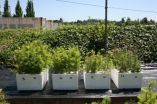(Press-News.org) WEST LAFAYETTE, Ind. - Purdue University researchers have found a genetic mutation that allows a plant to better endure drought without losing biomass, a discovery that could reduce the amount of water required for growing plants and help plants survive and thrive in adverse conditions.
Plants can naturally control the opening and closing of stomata, pores that take in carbon dioxide and release water. During drought conditions, a plant might close its stomata to conserve water. By doing so, however, the plant also reduces the amount of carbon dioxide it can take in, which limits photosynthesis and growth.
Mike Mickelbart, an assistant professor of horticulture; Mike Hasegawa, a professor of horticulture; and Chal Yul Yoo, a horticulture graduate student, found that a genetic mutation in the research plant Arabidopsis thaliana reduces the number of stomata. But instead of limiting carbon dioxide intake, the gene creates a beneficial equilibrium.
"The plant can only fix so much carbon dioxide. The fewer stomata still allow for the same amount of carbon dioxide intake as a wild type while conserving water," said Mickelbart, whose results were published in the early online version of the journal The Plant Cell. "This shows there is potential to reduce transpiration without a yield penalty."
Mickelbart and Yoo used an infrared gas analyzer to determine the amount of carbon dioxide taken in and water lost in the Arabidopsis mutant. Carbon dioxide is pumped into a chamber with the plant and the analyzer measures the amount left after a plant has started to take up the gas. A similar process measures water lost through transpiration, in which water is released from a plant's leaves.
Analysis showed that the plant, which has a mutant form of the gene GTL1, did not reduce carbon dioxide intake but did have a 20 percent reduction in transpiration. The plant had the same biomass as a wild type of Arabidopsis when its shoot dry weight was measured.
"The decrease in transpiration leads to increased drought tolerance in the mutant plants," Yoo said. "They will hold more water in their leaves during drought stress."
Of the 20 genes known to control stomata, SDD1 was highly expressed in the mutant. SDD1 is a gene that is responsible for regulating the number of stomata on leaves. In the mutant, with GTL1 not functioning, SDD1 is highly expressed, which results in the development of fewer stomata.
Mickelbart said the finding is important because it opens the possibility that there is a natural way to improve crop drought tolerance without decreasing biomass or yield. He said the next step in the research is to determine the role of GTL1 in a crop plant.
INFORMATION:
The National Science Foundation and a Binational Agricultural Research and Development Award funded the research.
Writer: Brian Wallheimer, 765-496-2050, bwallhei@purdue.edu
Sources: Michael Mickelbart, 765-494-7902, mmickelb@purdue.edu
Chan Yul Yoo, 765-494-1316, yoo6@purdue.edu
Abstract on the research in this release is available at: http://www.purdue.edu/newsroom/research/2011/110111MickelbartGene.html
END
In this winter of heavy snows--with more on the way this week--nature's bull's-eye might be Oswego, N.Y., and the nearby Tug Hill Plateau.
There the proximity of the Great Lakes whips wind and snow into high gear. Old Man Winter then blows across New York state, burying cities and towns in snowdrifts several feet high. This season, however, something is standing in his way.
The Doppler-on-Wheels (DOW), a data-collecting radar dish, is waiting. This month and next, scientists inside the DOW are tracking snowstorms in and around Oswego to learn what drives lake-effect ...
The growing popularity of solar photovoltaic (PV) systems across the United States has made it more important to maximize their power input. That's why UC San Diego environmental engineering professor Jan Kleissl is working on technologies and methods that will better predict how much power we can actually harness from the sun.
In a paper recently published in the journal Renewable Energy (http://www.sciencedirect.com/science/journal/09601481), "Optimum fixed orientations and benefits of tracking for capturing solar radiation in the continental United States," Kleissl ...
New York, Jan. 11, 2011 -- While scientists believe that climate change and related extreme weather events such as drought and flooding will likely affect the earth's flora and fauna, just how much is not known. A new study by researchers Walter Jetz from Yale University and Dustin Rubenstein from Columbia University however shows an important link between the natural variation in climate conditions and complex behaviors among birds.
The study, which appears in print in Current Biology on Jan. 11, 2011, has implications for understanding how organisms may respond behaviorally ...
JACKSONVILLE, Fla. — A study by researchers at Mayo Clinic's campus in Florida and Washington University School of Medicine adds a new twist to the body of evidence suggesting human obesity is due in part to genetic factors. While studying hormone receptors in laboratory mice, neuroscientists identified a new molecular player responsible for the regulation of appetite and metabolism.
In the Jan. 11 online issue of PLoS Biology, the authors report that mice engineered not to express the lipoprotein receptor LRP1, in the brain's hypothalamus, began to eat uncontrollably, ...
The opening of buds on Douglas-fir trees each spring is the result of a complex interplay between cold and warm temperatures during the winter, scientists with the U.S. Forest Service's Pacific Northwest Research Station have found.
Their research—which is featured in the December issue of Science Findings, a monthly publication of the station—led to the development of a novel model to help managers predict budburst under different scenarios of future climate.
"We take it for granted that buds will open each spring, but, in spite of a lot of research on winter dormancy ...
San Diego, CA, January 11, 2011 – Launched on December 2, 2010, Healthy People 2020 is an ambitious, science-based, 10-year agenda for improving the health of all Americans. A key component, Education for Health, is an educational roadmap to achieve the Healthy People 2020 goals. Formulated by the Healthy People Curriculum Task Force, this set of new and revised educational objectives provides a vehicle for promoting the discussion and progress that will be needed to achieve an integrated, seamless approach to education for health for the American public as well as for ...
ITHACA, N.Y. — Scientists have identified the genes related to leaf angle in corn (maize) – a key trait for planting crops closer together, which has led to an eight-fold increase in yield since the early 1900s. (Nature Genetics, Jan. 9, 2011.)
The study, led by researchers from Cornell and the U.S. Department of Agriculture – Agricultural Research Service (USDA-ARS) at Cornell and North Carolina State University, is the first to relate genetic variation across the entire maize genome to traits in a genomewide association study. The researchers have so far located 1.6 ...
Newly released findings of a multinational survey conducted on behalf of the International Osteoporosis Foundation (IOF) show clear disparities between patients' and doctors' perceptions of osteoporosis and its management.
The 13-country survey of 844 postmenopausal patients over 55 years of age and 837 doctors investigated gaps between patient and doctor understanding of the emotional and physical impact of osteoporosis; identified barriers to patient adherence; and sought to understand the ways in which osteoporotic patients can better share and obtain information about ...
Researchers from Rice University and Baylor College of Medicine (BCM) have broken one of the major roadblocks on the path to growing transplantable tissue in the lab: They've found a way to grow the blood vessels and capillaries needed to keep tissues alive.
The new research is available online and due to appear in the January issue of the journal Acta Biomaterialia.
"The inability to grow blood-vessel networks -- or vasculature -- in lab-grown tissues is the leading problem in regenerative medicine today," said lead co-author Jennifer West, department chair and the ...
A simple technique to make a common virus-killing material significantly more effective is a breakthrough from the Rice University labs of Andrew Barron and Qilin Li.
Rather than trying to turn the process into profit, the researchers have put it into the public domain. They hope wide adoption will save time, money and perhaps even lives.
The Rice professors and their team reported in Environmental Science and Technology, an American Chemical Society journal, that adding silicone to titanium dioxide, a common disinfectant, dramatically increases its ability to degrade ...


